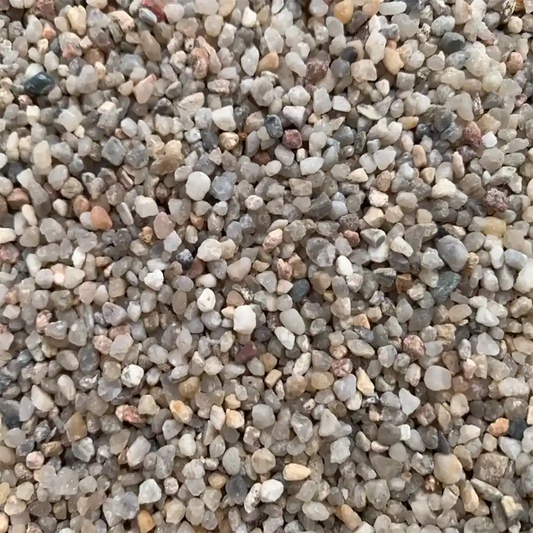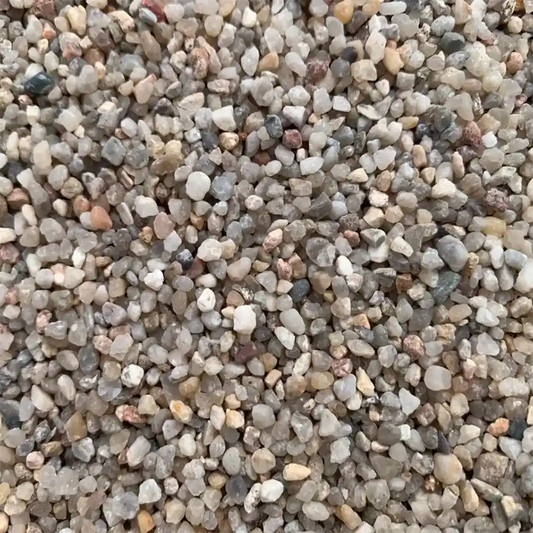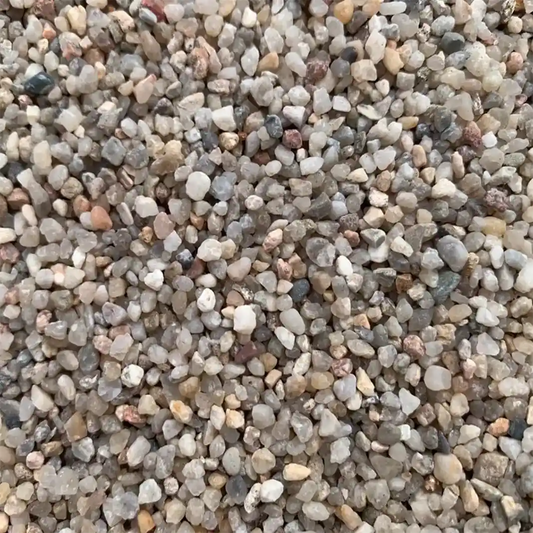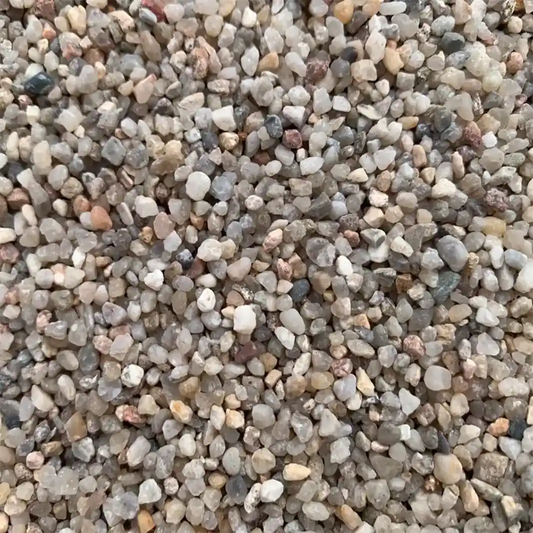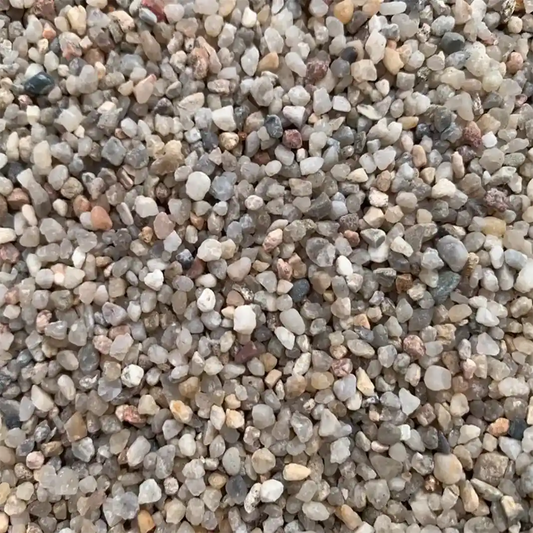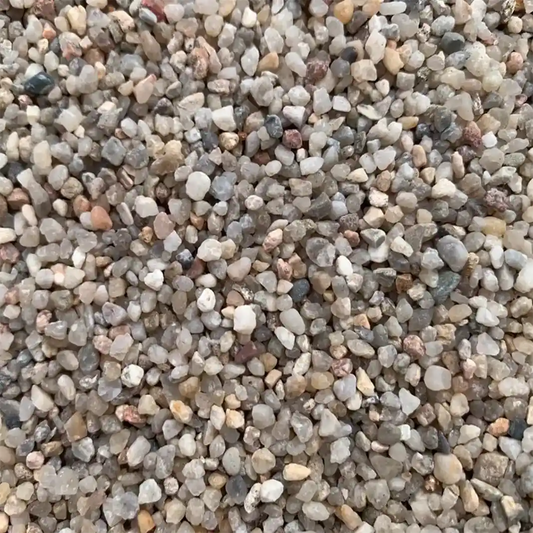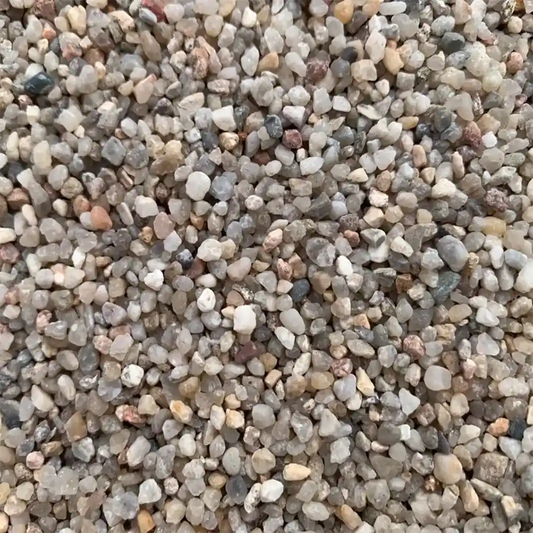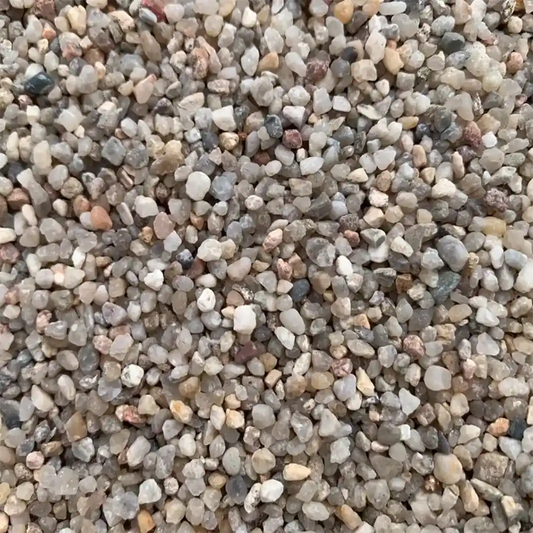
Collection: Quartz gravel
The diversity of quartz gravel: A useful and beautiful natural product for garden & terrace
Quartz gravel fits perfectly into a natural garden or terrace and can be used very well, for example, for a garden path.
Quartz gravel is a real all-rounder in garden design, whether you use it as decorative gravel for a flower bed, as a joint, or as a flooring. Also, in combination with another natural stone, you achieve a charming effect for your garden. In addition, there are other possible uses for quartz gravel, such as for water treatment, as a spreading or abrasive agent, or for use as aquarium gravel. It is therefore very suitable for garden and landscaping, as well as for swimming and fish ponds.
We use quartz gravel as a substructure for laying polygonal slabs.
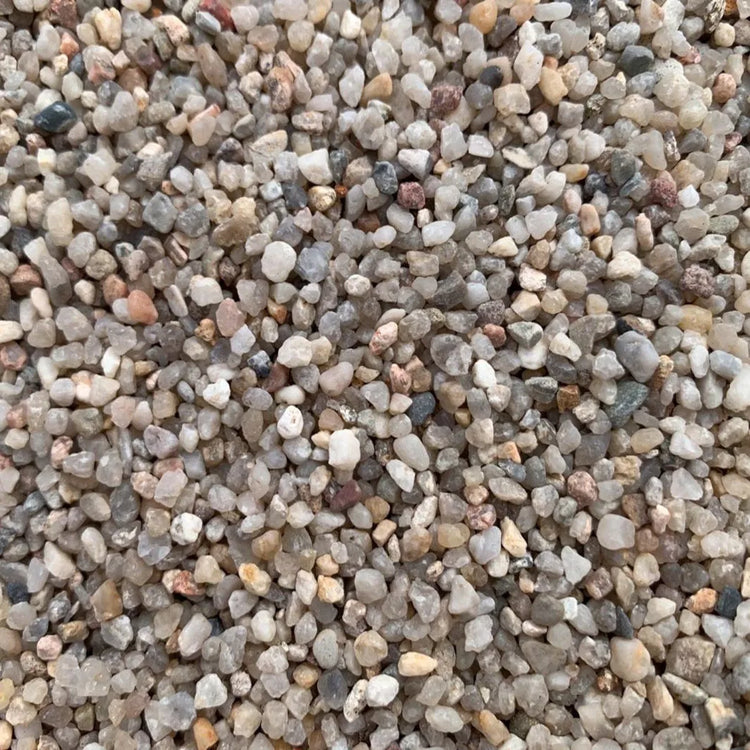
Quartzite is a very hard rock ...
... which is used for many different purposes, including building material, fillers, and decoration. There are different types of gravel, including decorative gravel, grit, and decorative stones. For laying polygonal slabs, we recommend gravel with a grain size of 2-4 mm. Quartz gravel as a natural product is a naturally occurring mineral rock fragment, mostly consisting of rock from the Earth's mantle. It contains many minerals, including quartz, feldspar, and mica. We use it in a finer grain size as joint mortar to create a robust and water-permeable joint between natural stones. Colored quartz gravel is produced by color coating to achieve a unique and attractive appearance in garden design and landscaping.
Versatility and durability are further characteristics of quartz gravel, as well as resistance to chemical erosion and weathering changes. It also serves as a very good drainage material and can be used in laying paving stones, rubble stones for garden paths, bed edgings, or garden terraces. Quartz gravel is also used as a filler in mortar and concrete products and is a very powerful and durable material that contributes to increasing the strength and density of concrete products.
What makes the pre-treated quartz gravel from bruchsteinplatten.de special?
The special feature of our quartz gravel is that it has been washed twice and flamed once. This pretreatment avoids the unclean, dusty, and crumbly consistency typically found in conventional quartz gravel. Through the double washing process and flaming, a largely clean grain is obtained, which is important for the resin to form a clean bond with the quartz gravel. We recommend before using the stones, to drop the bag from a height of about 50 cm onto the ground in a controlled and jerky manner so that the remaining dust particles can settle at the bottom of the bag.
bruchsteinplatten.de
Premium quartz gravel 3-6 mm grain size 1000 kg
Share
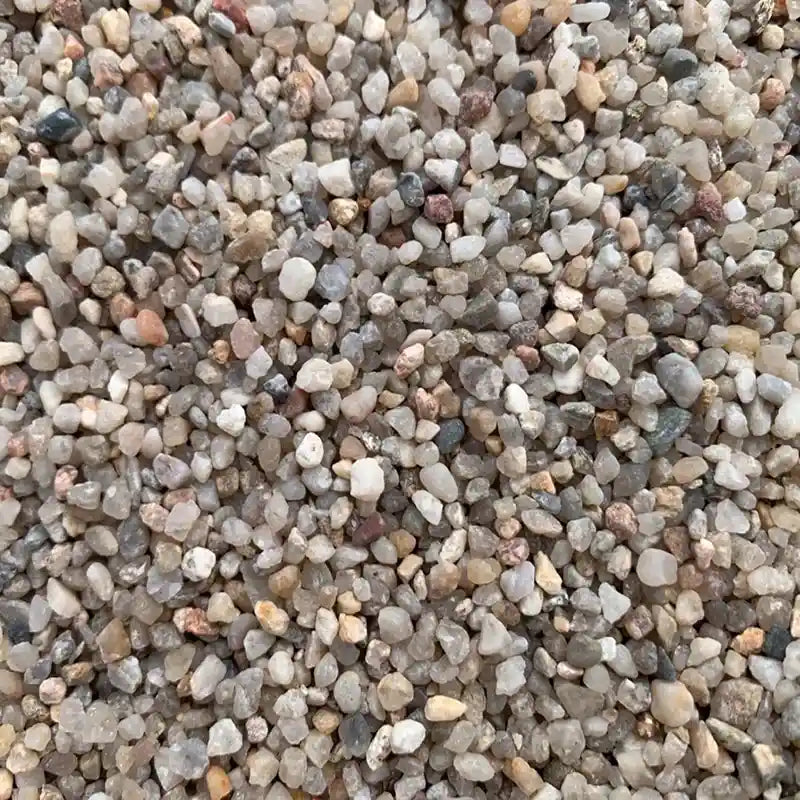
Terrace substructure packages with premium quartz gravel
Quartz gravel, resin, colored quartz gravel joint mortar, and impregnation for laying natural stone slabs on your terrace without concrete.
-
Terrace substructure and joint mortar for 10 sqm natural stone slabs
Vendor:bruchsteinplatten.deRegular price €1.876,00 EURRegular priceUnit price €187,60/m² -
Terrace substructure and joint mortar for 20 sqm natural stone slabs
Vendor:bruchsteinplatten.deRegular price €2.776,00 EURRegular priceUnit price €138,80/m² -
Terrace substructure and joint mortar for 30 sqm natural stone slabs
Vendor:bruchsteinplatten.deRegular price €4.086,00 EURRegular priceUnit price €136,20/m² -
Terrace substructure and joint mortar for 40 sqm natural stone slabs
Vendor:bruchsteinplatten.deRegular price €5.231,00 EURRegular priceUnit price €130,78/m² -
Terrace substructure and joint mortar for 50 sqm natural stone slabs
Vendor:bruchsteinplatten.deRegular price €6.301,00 EURRegular priceUnit price €126,02/m² -
Terrace substructure and joint mortar for 60 sqm natural stone slabs
Vendor:bruchsteinplatten.deRegular price €7.391,00 EURRegular priceUnit price €123,18/m² -
Terrace substructure and joint mortar for 70 sqm natural stone slabs
Vendor:bruchsteinplatten.deRegular price €8.396,00 EURRegular priceUnit price €119,94/m² -
Terrace substructure and joint mortar for 80 sqm natural stone slabs
Vendor:bruchsteinplatten.deRegular price €9.366,00 EURRegular priceUnit price €117,08/m²
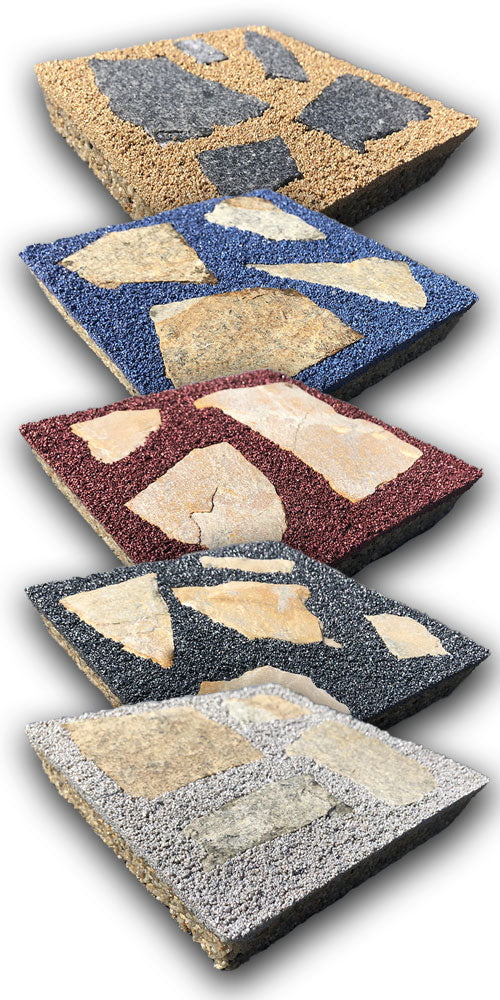
Quartz gravel and synthetic resin as joint mortar
Quartz gravel is a commonly used material for the production of joint mortar. It is a particularly hard rock, usually available in the form of finely ground grains in various colors and sizes. Quartz gravel is a very resilient material and is therefore particularly suitable for use as joint material. The quartz gravel is mixed with a special joint mortar to create a robust, durable, and water-permeable joint without concrete. The mortar can be applied in different colors to achieve an aesthetically pleasing result.
Colored quartz gravel (Colorquarz) is produced by using a color coating process, where the gravel grains are immersed in a solution with a color. This can be done either by dipping in a colored solution or by using a special color coating process. The color coating process can be produced in a variety of colors, giving the grains a unique and attractive appearance. Colored quartz gravel is a popular choice for landscape design projects, as the different colors and patterns offer a variety of aesthetic properties and effects. The gravel can also be used as decoration for plants, gardens, and paths.
FAQ - Answers to frequently asked questions
Quartz gravel what is it?
Quartz gravel is a rock consisting of quartz in the form of small grains, gravel, or pebbles. Quartz gravel is a commonly occurring rock that is mined in many areas of the world. It is a very hard rock suitable for many different purposes due to its hard grains. Because of its durability, it is often used as a building material and as a component of various mixtures. Additionally, it can be used as a decorative element or as a filler for garden paths and for laying polygonal slabs.
What is quartz gravel used for?
Quartz gravel is very hard and durable, which is why it is often used as a building material and as a component of various mixtures. It can also be used as decorative elements or as a filler for garden paths and for laying polygonal slabs. Quartz gravel is frequently used as an aggregate in building materials such as concrete, cement, and asphalt. It is also used in process engineering and horticulture. Quartz gravel is used to structure, protect, and stabilize soil and other materials. It can also be used as a filler to improve the strength, density, and other properties of building materials.
What are the possible uses of quartz gravel?
- Quartz gravel is mainly used in the construction industry
- as filling material to fill up the ground in construction pits, roads, and rivers
- in the areas of paving, road construction, drainage, and as an aggregate for concrete
- in landscaping
- in gardening to build paths, walkways, and bed edgings
- as joint mortar for laying polygonal slabs
- in aquaculture and aquariums, quartz gravel is used to design the substrate
- in the chemical and pharmaceutical industry, it is used as a heat conductor, as an absorbent, and for the production of cleaning chemicals
- in metallurgy, it is used for the production of copper alloys, for furnace insulation, and as an abrasive
- as filter gravel for car washes or pool pumps
How do decorative gravel, chippings, and decorative stones differ?
Decorative gravel, chippings, and decorative stones are different types of rocks used for garden decoration. Decorative gravel is a fine-grained rock that is typically used as ground cover or as a decorative mulch layer. Chippings consist of smaller stones and pebbles that are used as mulch or as edging for garden decoration. Decorative stones are larger rocks used as decorative elements in gardens and other public spaces.
Is quartz gravel a natural product?
Yes, quartz gravel is a natural product. It is a naturally occurring mineral rock fragment, mostly consisting of rock from the Earth's mantle. It contains many minerals, including quartz, feldspar, and mica.
Which gravel is the right one for the terrace?
It all depends on your preferences and how the rest of your garden looks. For example, if you have a modern garden, gravel in lighter colors can be a good option. However, if you have a more traditional garden, darker gravel will be the better choice. There are also different types of gravel, such as chippings, gravel, or pebbles. If you are unsure, it is recommended to consult a professional to find out which gravel is best suited for your terrace or project.
Which gravel is the right one for laying polygonal slabs / natural stone slabs / broken stone slabs?
For the installation of polygonal slabs, a gravel with a grain size of 2-4 mm should be used. This quartz gravel is finer than regular gravel and can also be used as joint material. It is also suitable for drainage and easy to work with. The gravel must be spread before laying the natural stone slabs so that it forms a level surface. However, the gravel should not be laid too densely, as this would impair the drainage capability of the subsoil. Subsequently, the polygonal slabs can be laid.
Do you want to buy quartz gravel in a grain size of 2-4 mm to create a garden path or for mixing with joint mortar?
Yes, Quarzkies 2-4 mm is suitable for both the garden path as well as for mixing with joint mortar.
Are you looking for quartz gravel for business purposes?
For business purposes, we offer quartz gravel in various sizes and colors. Delivery is available in 25 kg bags and as Big Bag quartz gravel with 1,000 kg or 1 ton on a pallet for the large-scale needs of a garden and landscaping professional.
COMPRESA - Premium quality. Everything included at an affordable package price. Free delivery to your doorstep.
Choose your desired color for the joint and the desired impregnation (Nature Effect or color intensifying). All necessary materials such as polygonal slabs including 10% extra, binder, quartz gravel, color quartz, and impregnation are already included in this all-inclusive package.



